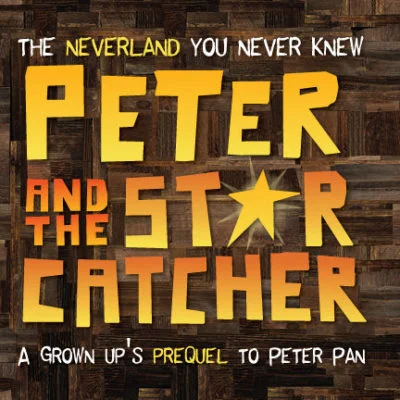Peter and the Starcatcher
Based on the Novel by Dave Barry and Ridley Pearson
Music by Wayne Barker
Directed by William Osetek
Musical Direction by Ben Johnson
Produced by Drury Lane, Oak Brook Terrace
Good Things Come to Those Who Wait
Peter and the Starcatcher’s original publicists gave it the tagline “a grown-up’s prequel to Peter Pan.” They were wise to do so. This regional premiere, adapted by Rick Elice from the pre-teen novel by humor columnist Dave Barry and Disney novelizer Ridley Pearson, continues what has been a highly risky pattern by Drury Lane recently of picking plays that are about children, but not for them, at least not young ones. The issue with Starcatcher, specifically, is its length. At about two and a half hours, this production is shorter than the Broadway tour and typical of a musical (which this show is not), but inappropriate for the children young enough to be audience members at the usual Peter Pan pantomimes. Furthermore, the reason for Starcatcher’s length is the writers’ inability to resist stuffing an excessive number of Vaudeville, music hall, and drag style comedic routines into the show, and particularly, its first act. For audiences who know to expect meandering zaniness, the ninety minute intro offers marvels of stage craft along with goofy jokes and an immensely talented, spirited cast. But it’s the second act, when the show finally starts taking its characters and themes seriously, that makes Starcatcher worth seeing, and provides a context for its humor to work off of. If you go, you’d be cheating yourself if you don’t stay for the whole thing.
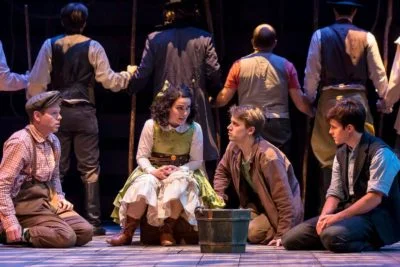
The first act concerns three intersecting plots on two ships, the Neverland and the Wasp. The captain of the Neverland, Bill Slank (Rhett Guter), has been hired by an evil orphanage manager to deliver three adolescent boys to the distant King Zarboz, who intends to “feed them to his giant snake.” The boys are Prentiss (Aaron Kirby), Ted (Zack Colonna), and a nameless, brooding young man who is the future Peter Pan (Caleb Donahoe). Slank is also transporting Molly Aster (Emma Rosenthal), the daughter of an important nobleman (Rod Thomas), and her governess, Mrs. Bumbrake (John Keating). Molly and her father are part of a secret government agency called Starcatchers, whose job is to collect and maintain the magical dust that falls from stars. Lord Aster is aboard the Wasp, intending to deliver a trunk full of the starstuff to Zarbuz’s kingdom, and destroy it in the world’s hottest volcano. Molly is on the other ship because Lord Aster believed it to be safer, but actually, both ships contain conspirators. Slank switched the trunk full of starstuff with one full of sand in the port, and is keeping it aboard the Neverland. Meanwhile, The Wasp has been infiltrated by a pirate called Black Stache (Matt Mueller), the future Captain Hook, who knowing only that Lord Aster is transporting something extremely valuable, seizes the ship.
Realizing that their mission is in danger, Molly recruits the aid of the three boys, who she has tried to befriend. She forms an especially close bond with the nameless one, who she recognizes as the smartest and most mature after he rebukes her initial high-handed conduct. Hoping to reunite Lord Aster with the right trunk, the Boy steers the Neverland into the Wasp, dooming the former. In an attempt to save him from drowning, Molly pushes the trunk of starstuff to him, allowing him to float to a nearby island at the price of exposing the environment to its contents. That is where Act I ends, and Act II is devoted to the kids’ adventures in which they learn the value of leadership and trust while battling the Black Stache and island natives.
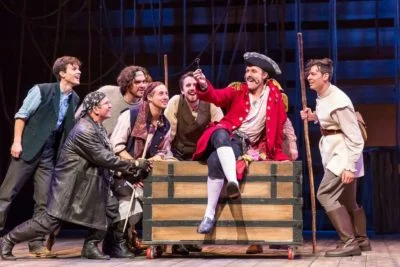
Director William Osetek played the story much lighter than he could have. The child trafficking plot is glossed over quickly, with much more time devoted to bits like Lord Aster and Molly speaking in dodo, and Molly intruding on private moments all over her ship. As a result, the comedic bits aren’t a relief, so much as an endless series of random events. While Act II contains plenty of similar moments, such as “Norse Code,” the script forced the director to focus more on developing the Boy’s character. Chicago newcomer Caleb Donahoe, who had been playing his character seriously all through the first act, finally gets a chance to shine as the Boy gets a name and experiences kindness and pride for the first time in his miserable, lonely life. Emma Rosenthal, the one woman in the cast, displays great skill in making know-it-all Molly likable instead of obnoxious, and gets along very well with Donahoe, establishing a friendship you can root for. Kirby and Colonna, the lost boys, whose characters are a lot like Merry and Pippin, are also highly flexible (physically and stylistically) and help carry the emotional arc of the story.
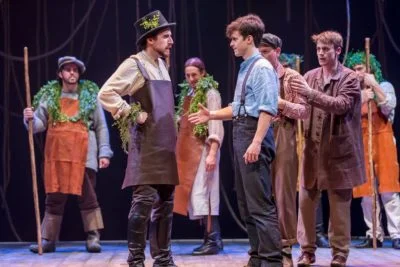
Really, the whole cast is charming and physically adept. Matt Mueller is over-the-top as the Black Stache, but that seems right for Captain Hook, and Jeff Dumas as his sidekick Mr. Smee is a master of Vaudeville comedy. John Keating, as Mrs. Bumbrake, is the only drag queen outside of a mermaid dance number at the beginning of the second act, but the nature of the show is that there seem to be a lot more. In almost every scene, the entire company assembles to play both a chorus and their named characters, and use acrobatics and very basic props like bamboo poles to create locations and furnishings, and even ship prows. Rhett Gutter’s choreography is as complex as in any musical, and the design team of Scott Davis, Sally Dolembo, Ray Nardelli, and Cassy Schillo provided an abstract world in which all kinds of staging devices could be used to great effect. I particularly enjoyed the beautiful green, blue, and purple lighting and the complex rigging, which fire the imagination (the prologue invites us to play along by inventing a story on a blank stage). There are only a few songs, but an orchestra, led by Ben Johnson, provides live sound effects all night.
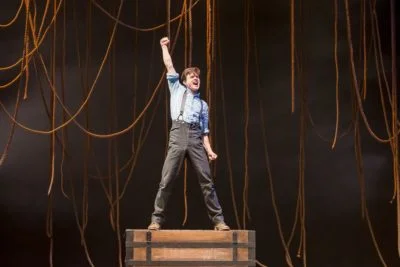
Peter and the Starcatcher is certainly a masterpiece of creative energy as far as staging goes. And a large portion of the dialogue is indeed funny, satirical, or sweet. An audience just has to know what they’re getting beforehand. At one point, Molly explains to the Boy that the starstuff could be dangerous if it were to fall into the hands of a tyrant “like Caesar, or Napoleon, or Ayn Rand.” “Or Queen Victoria?” he asks. “No, that’s different,” she replies. This is one of the better examples of the show’s fourth-wall breaking humor. Others involve squid poop. In Act II, the children perform a pantomime of Sleeping Beauty that is daringly similar to the show they are actually in. Osetek’s focus on the humor means the story takes a while to find its substance. When it does, it is a fine tribute to J.M. Barrie’s moving, but haunting original. But reaching that point requires patience, and until then, the audience would do best to join in the light-hearted fun.
Recommended
Jacob Davis
This show has been Jeff recommended.
Playing at Drury Lane Theatre, 100 Drury Lane, Oak Brook Terrace, Illinois. Tickets are $40-55 with discounts for groups, students, and seniors, and dinner packages available; to order, call 630-530-0111

